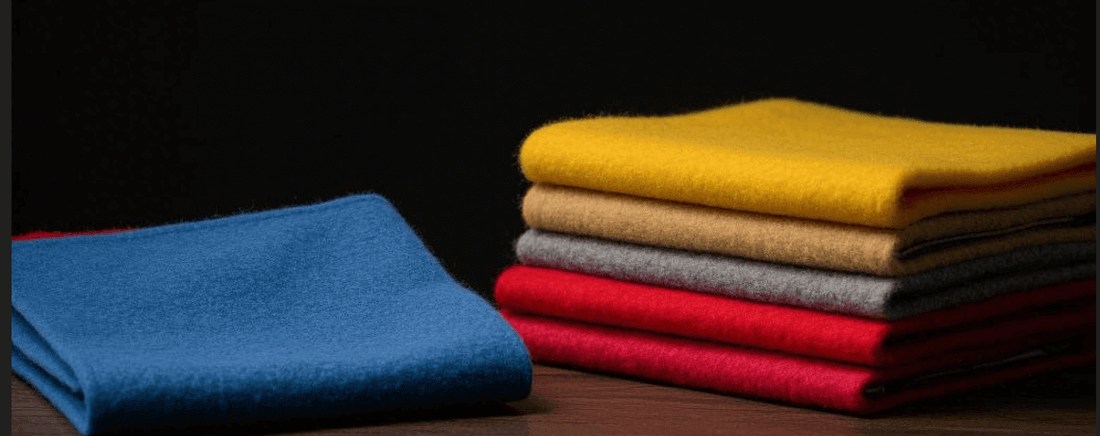Fleece vs. Felt: A Comprehensive Comparison

When it comes to cozy blankets, the choice of material can make all the difference in comfort and functionality. Two popular options that often get compared are fleece and felt. Though both materials are used for warmth and have a soft, inviting feel, they are quite distinct in their properties and uses.
What is Fleece?
Fleece is a synthetic fabric, often made from polyester, that is designed to resemble the softness and warmth of wool. It is created through a process of knitting or weaving fibers, followed by brushing them to create a soft, fluffy texture. One of the defining characteristics of fleece is its lightweight nature combined with excellent insulating properties. Fleece blankets are known for being soft, breathable, and easy to care for. They are often chosen for their ability to wick moisture away from the body while maintaining warmth, making them ideal for outdoor activities like camping or as a cozy addition to your living room sofa.
Fleece is also quite versatile, available in a variety of thicknesses, from lightweight throws to heavier blankets. Additionally, fleece is quick-drying and generally resistant to wrinkling, which makes it a practical choice for everyday use.
What is Felt?
Felt, on the other hand, is a non-woven fabric that is created by matting, pressing, and bonding fibers together. It is most commonly made from wool, although synthetic fibers (such as acrylic or polyester) can also be used. The fibers are compressed together without weaving or knitting, which results in a dense, durable material that feels firm and structured.
Unlike fleece, felt has a rougher texture and does not have the soft, velvety feel of synthetic materials. Felt is often used in crafting, home decor, and certain types of clothing. Wool felt, in particular, is known for its excellent insulation properties, as the air trapped within the dense fibers helps keep warmth close to the body.
While felt is not as flexible or soft as fleece, it offers a unique, stiff, and structured look, making it a favorite for more rustic, artistic, or formal decor. Additionally, felt is a material that ages gracefully, becoming softer with time without losing its durability.
Texture Comparison: Fleece vs. Felt
Fleece: This fabric is known for its soft, plush feel, which is similar to the texture of a thick, cozy sweater. Its surface is smooth, with a slight stretch that adds to its comfort. Fleece has a fleecy, almost velvety feel when touched, making it ideal for blankets you want to cuddle up with. The material is lightweight and flexible, which gives it a more casual and approachable feel.
Felt: In contrast, felt feels more dense and firm. It does not have the same smooth, velvety texture that fleece offers. Felt has a rougher feel, with a slight graininess due to the matting of fibers. It can feel stiff initially, especially in thicker versions, and does not have the same amount of stretch or flexibility as fleece. However, this stiffness can give felt a more structured, artisanal quality, often preferred in decorative or functional items that need to maintain their shape.
Appearance Comparison: Fleece vs. Felt
Fleece: Fleece often has a soft sheen to it, particularly when brushed, giving it a smooth, sleek look. Its surface can have a slightly fuzzy texture that contributes to its cozy and inviting aesthetic. Fleece comes in a variety of colors and patterns, from solid hues to vibrant prints, making it a popular choice for blankets, throws, and other household textiles. Its flexibility and softness make it a great material for cozy, casual decor.
Felt: Felt has a matte finish and appears more dense and uniform in texture. Wool felt, especially, can have a slightly rustic or natural look, with more visible texture due to the compressed fibers. Felt often has a more solid, structured appearance, which makes it a popular choice for more formal or vintage decor. It can be found in a wide range of colors but generally maintains a more subdued or earthy palette, particularly when made from natural fibers.
In summary, fleece offers a softer, smoother appearance and is more flexible, while felt tends to have a stiffer, more structured look with a matte, natural finish.
Warmth Comparison: Fleece vs. Felt
Fleece: Fleece is known for its lightweight warmth. While it may not be as thick as felt, it traps air within its fibers, which creates an insulating effect that keeps you warm without adding excessive bulk. Fleece blankets are ideal for layering in colder weather, as they can keep you warm without feeling too heavy. Additionally, fleece is moisture-wicking, so it helps regulate body temperature by drawing moisture away from your skin, keeping you dry and comfortable.
Felt: Felt, especially wool felt, is excellent at retaining heat. The dense structure of felt traps air in between the fibers, providing a greater level of insulation than fleece. As a result, felt is particularly well-suited for colder climates or when you need something thicker and more substantial. While it may feel heavier than fleece, its dense, matted fibers offer exceptional warmth, especially when made from natural wool. Felt can feel bulkier, but it provides an enduring level of heat retention.
Conclusion
Fleece and felt each offer unique advantages depending on your needs. Fleece is lightweight, soft, and breathable, making it perfect for casual comfort and layering in colder weather. Felt, on the other hand, is denser and more insulating, ideal for colder climates or when you need something more structured and durable.
